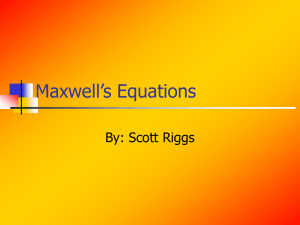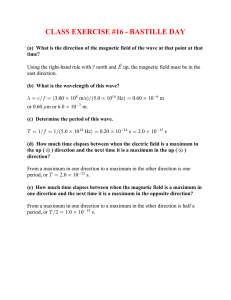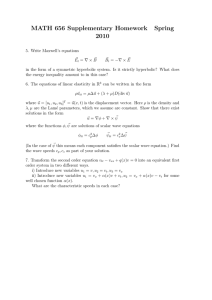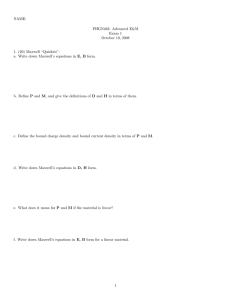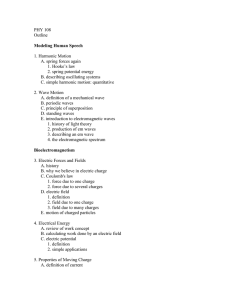8-29 Maxwells equations
advertisement
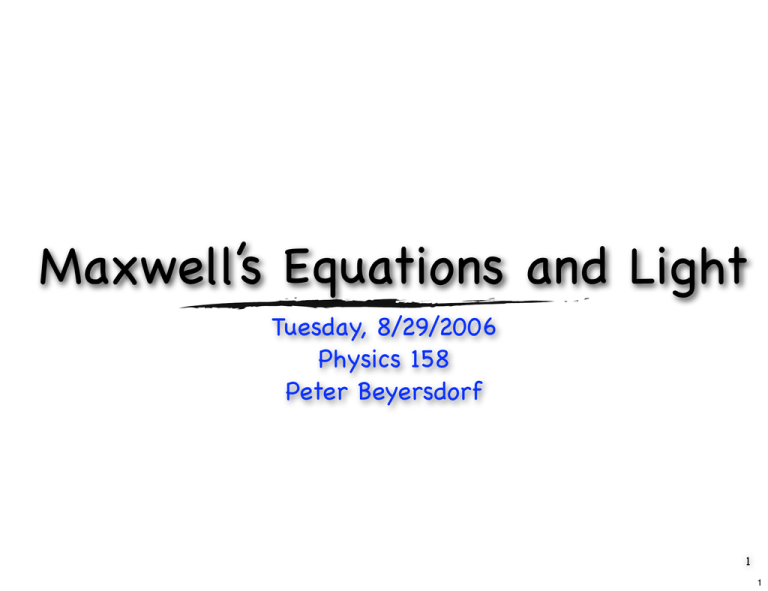
Maxwell’s Equations and Light Tuesday, 8/29/2006 Physics 158 Peter Beyersdorf Document info 1 1 Class Outline Maxwell’s Equations The Wave Equation Light versus other EM waves 2. 2 2 Maxwell’s Equations How do Maxwell’s equations describe the propagation of Light? 2. 3 3 Maxwell’s Equations Consider Maxwell’s equations in differential form Gauss’ law (for electricity) Faraday’s law Gauss’ law (for magnetism) Ampere’s law What do each of these mean? 2. 4 4 Gauss’ Law Electrical charges are the source of the electric field The strength of the electric field depends on the material it is in (via ε) ε can be determined via measurements on a parallel plate capacitor filled with a given material using the equation C=εA/d 2. 5 5 Faraday’s Law The Curl of the electric field is caused by changing magnetic fields A changing magnetic field can produce electric fields with field lines that close on themselves 2. 6 6 Gauss’ Law for Magnetism There are no source of magnetic fields No magnetic monopoles Magnetic field lines can only circulate 2. 7 7 Ampere’s Law The Curl of the magnetic field is caused by current of charged particles (J) or of the field they produce (dE/dt) A changing electric field can produce magnetic fields (with field lines that close on themselves) The strength of the field depends on the material (via μ - in common materials μ=μo) μ can be measured by using the Biot-Savart law 2. 8 8 Waves and Maxwell’s Equations A charged particle is a source of an electric field When that particle moves it changes the (spatial distribution of) the electric field When the electric field changes it produces a circulating magnetic field If the particle accelerates this circulating magnetic field will change A changing magnetic field produces a circulating electric field 2. 9 9 Derivation of the Wave Equation Starting with Faraday’s law take the curl of both sides use vector calculus relationship to get Use Ampere’s law (in free space where J=0) and Gauss’ law (in free space where ρ=0) 2.10 10 Spherical Solutions to the Wave Equation Consider solutions for E such that ∇2E and δ2E/dt2 are both proportional to E - allowing the two sides to differ only by a constant term. is one such solution in spherical coordinates. Using the relationship for the Laplacian of a spherically symmetric function: Show that "" " given above is a solution to the 11 wave equation 2. 11 Solutions to the Wave Equation Recall the meaning of k and ω (k=2π/λ, ω=2π/T) we can express this as Since λ is the distance travelled by the wave in one cycle, and T is the time to travel one cycle, λ/T is the velocity of the wave, which can be determined from electrostatics and magnetostatics! 12 2. 12 Speed of Light In free-space where ε=ε0 and μ=μ0 the speed of light is defined to be c 299792458 m/s. In this sense any measurement of the speed of light in a vacuum is really a measurement of the length of a meter (the unit of time is also a defined quantity) In material where ε=κε0 and μ=μrμ0 the speed of light is v=c/(κμr)1/2. We let n (κμr)1/2 and call n the index of refraction for a material. What is the physical interpretation of n? If it is complex, what do the real and imaginary parts represent? 2.13 13 Index of Refraction From our expression for the velocity of the wave v=c/(κμr)1/2 we can substitute n=(κμr)1/2 to get v=c/n Thus n represents how much slower light travels in a material compared to free space. Given the relation c=v/n=ω/k. If a wave travels from free space into a material causing it to slow down, does ω change, or does k change (or both)? 2.14 14 Index of Refraction Consider a wave in free space entering a material. Doe the wavelength change, does the frequency change or both? The frequency cannot change (or else the boundary would be discontinuous) so the wavelength (and hence k) must change so that λ=λ0/n and k=nk0 2.15 15 Index of Refraction Going back to the solution to the wave equation, we can express it explicitly for propagation in a material with index of refraction n If n is complex such that n=n’+i n” we have and we see n” is related to the absorption coefficient α used in Beer’s law by α=2n”k0. 2. 16 16 Solutions to the Wave Equation From our solution and Gauss’ law in free space (ρ=0) We find that since"" " " only has a spatial dependance on r its divergence must be 17 implying " " " " " " meaning this is a transverse wave2. 17 Describing Light Since the Electric & Magnetic fields are both transverse to the direction of propagation, the direction of propagation can be found by the direction of their cross product. Since the irradiance is proportional to the square of the eletric field, and the electric field is proportional to the magnetic field, the irradiance of a wave is proportional to the cross product of E and B Poynting vector" " " " " " " " gives the instantaneous flow of energy per unit area per unit time 2.18 18 Describing Light Irradiance is the average power per unit area per unit time it is often called the “intensity” The power passing through an area dA is The average photon flux (number of photons per second) is The rms variation in the photon flux over a time τ is 2.19 19 Summary Maxwell’s equations result in electromagnetic waves that are transverse disturbances int he electric and magnetic fields moving at a speed of v=(εμ)-1/2 The index of refaction, n, describes the relative speed of light through a material (real part) and the absorption in that material (imaginary part) Light can be described by various quantities Poynting vector irradiance power photon flux 2.20 20
